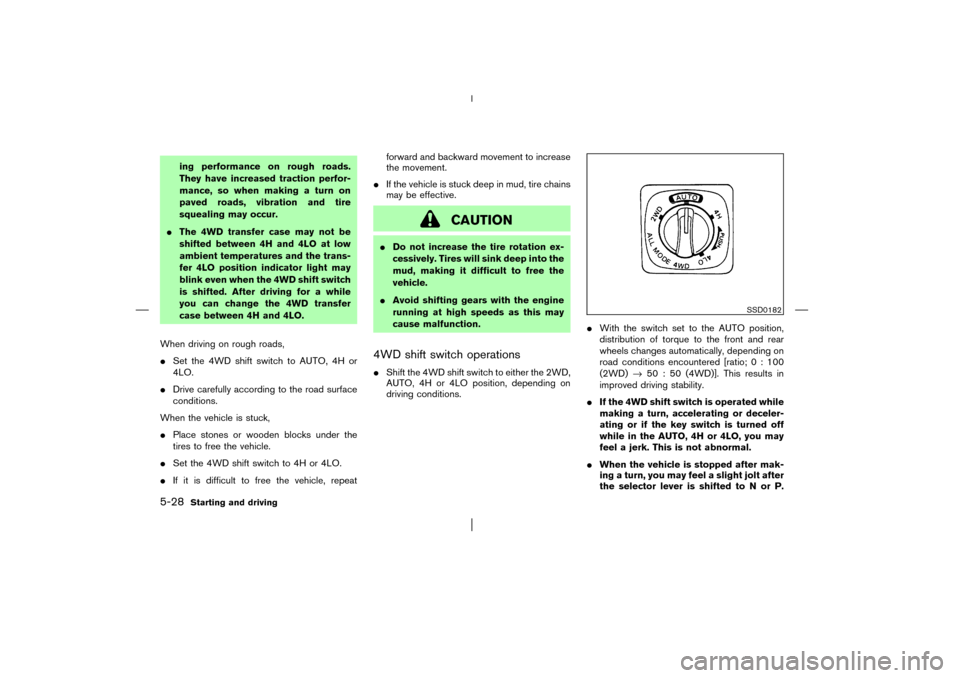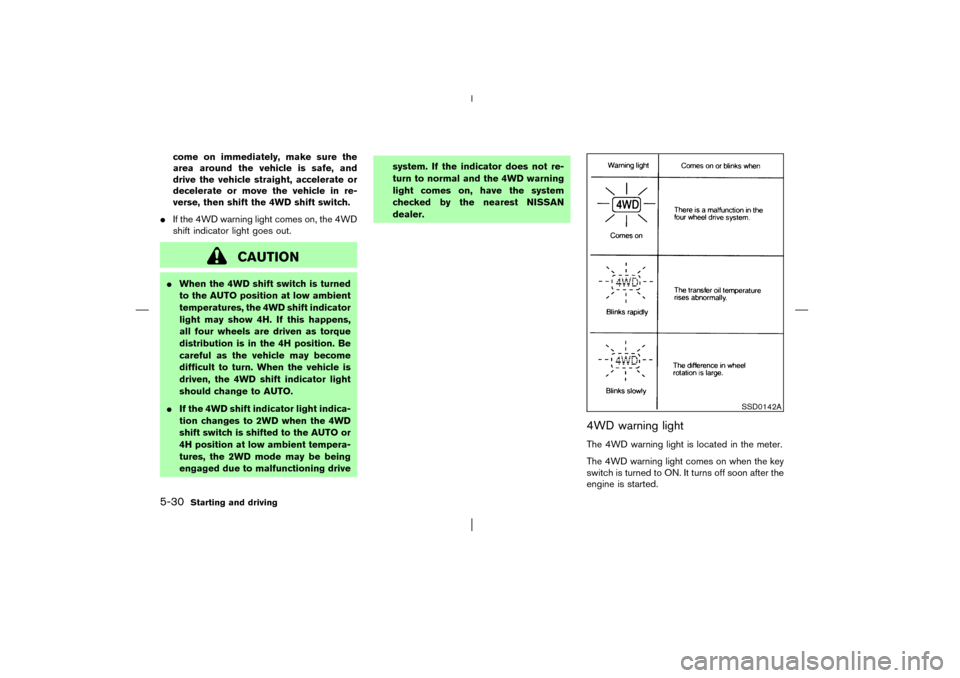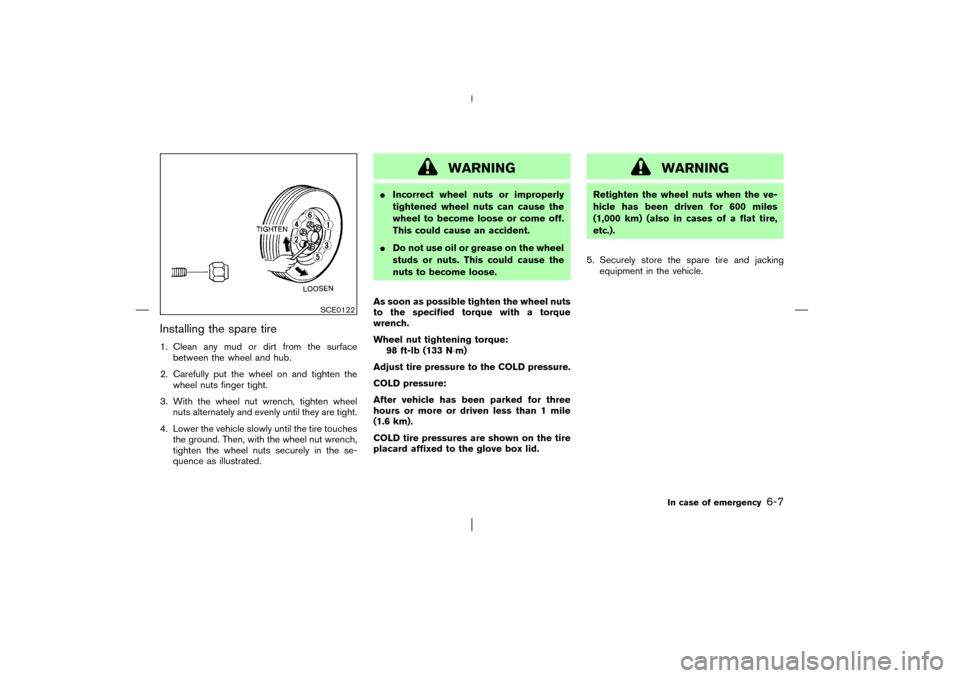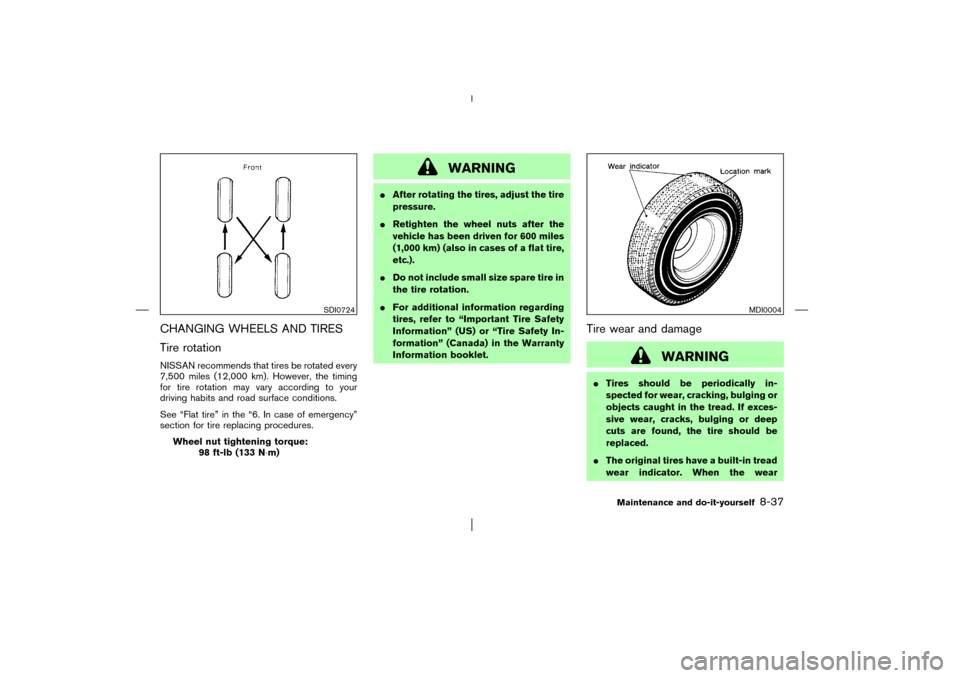Page 185 of 299

ing performance on rough roads.
They have increased traction perfor-
mance, so when making a turn on
paved roads, vibration and tire
squealing may occur.
�The 4WD transfer case may not be
shifted between 4H and 4LO at low
ambient temperatures and the trans-
fer 4LO position indicator light may
blink even when the 4WD shift switch
is shifted. After driving for a while
you can change the 4WD transfer
case between 4H and 4LO.
When driving on rough roads,
�Set the 4WD shift switch to AUTO, 4H or
4LO.
�Drive carefully according to the road surface
conditions.
When the vehicle is stuck,
�Place stones or wooden blocks under the
tires to free the vehicle.
�Set the 4WD shift switch to 4H or 4LO.
�If it is difficult to free the vehicle, repeatforward and backward movement to increase
the movement.
�If the vehicle is stuck deep in mud, tire chains
may be effective.
CAUTION
�Do not increase the tire rotation ex-
cessively. Tires will sink deep into the
mud, making it difficult to free the
vehicle.
�Avoid shifting gears with the engine
running at high speeds as this may
cause malfunction.4WD shift switch operations�Shift the 4WD shift switch to either the 2WD,
AUTO, 4H or 4LO position, depending on
driving conditions.�With the switch set to the AUTO position,
distribution of torque to the front and rear
wheels changes automatically, depending on
road conditions encountered [ratio;0:100
(2WD)→50 : 50 (4WD)]. This results in
improved driving stability.
�If the 4WD shift switch is operated while
making a turn, accelerating or deceler-
ating or if the key switch is turned off
while in the AUTO, 4H or 4LO, you may
feel a jerk. This is not abnormal.
�When the vehicle is stopped after mak-
ing a turn, you may feel a slight jolt after
the selector lever is shifted to Nor P.
SSD0182
5-28
Starting and driving
�
03.1.28/R50-D/V5
�
Page 187 of 299

come on immediately, make sure the
area around the vehicle is safe, and
drive the vehicle straight, accelerate or
decelerate or move the vehicle in re-
verse, then shift the 4WD shift switch.
�If the 4WD warning light comes on, the 4WD
shift indicator light goes out.
CAUTION
�When the 4WD shift switch is turned
to the AUTO position at low ambient
temperatures, the 4WD shift indicator
light may show 4H. If this happens,
all four wheels are driven as torque
distribution is in the 4H position. Be
careful as the vehicle may become
difficult to turn. When the vehicle is
driven, the 4WD shift indicator light
should change to AUTO.
�If the 4WD shift indicator light indica-
tion changes to 2WD when the 4WD
shift switch is shifted to the AUTO or
4H position at low ambient tempera-
tures, the 2WD mode may be being
engaged due to malfunctioning drivesystem. If the indicator does not re-
turn to normal and the 4WD warning
light comes on, have the system
checked by the nearest NISSAN
dealer.
4WD warning lightThe 4WD warning light is located in the meter.
The 4WD warning light comes on when the key
switch is turned to ON. It turns off soon after the
engine is started.
SSD0142A
5-30
Starting and driving
�
03.1.28/R50-D/V5
�
Page 204 of 299

Installing the spare tire1. Clean any mud or dirt from the surface
between the wheel and hub.
2. Carefully put the wheel on and tighten the
wheel nuts finger tight.
3. With the wheel nut wrench, tighten wheel
nuts alternately and evenly until they are tight.
4. Lower the vehicle slowly until the tire touches
the ground. Then, with the wheel nut wrench,
tighten the wheel nuts securely in the se-
quence as illustrated.
WARNING
�Incorrect wheel nuts or improperly
tightened wheel nuts can cause the
wheel to become loose or come off.
This could cause an accident.
�Do not use oil or grease on the wheel
studs or nuts. This could cause the
nuts to become loose.
As soon as possible tighten the wheel nuts
to the specified torque with a torque
wrench.
Wheel nut tightening torque:
98 ft-lb (133 N⋅m)
Adjust tire pressure to the COLD pressure.
COLD pressure:
After vehicle has been parked for three
hours or more or driven less than 1 mile
(1.6 km).
COLD tire pressures are shown on the tire
placard affixed to the glove box lid.
WARNING
Retighten the wheel nuts when the ve-
hicle has been driven for 600 miles
(1,000 km) (also in cases of a flat tire,
etc.).
5. Securely store the spare tire and jacking
equipment in the vehicle.
SCE0122
In case of emergency
6-7
�
03.1.28/R50-D/V5
�
Page 205 of 299
Stowing the damaged tire and toolsSecurely store the tire and jacking equipment in
the vehicle as illustrated.
WARNING
�Always make sure that the spare tire
and jacking equipment are properly
secured after use. Such items can
become dangerous projectiles in an
accident or sudden stop.
�The small size spare tire is designedfor emergency use. See “Tires and
wheels” in the “8. Maintenance and
do-it-yourself” section.
Tightening torque of nuts:
48 to 66 ft-lb
(66 to 89 N⋅m)
Use a suitable padlock.
SCE0339C
SCE0244
6-8
In case of emergency
�
03.1.28/R50-D/V5
�
Page 258 of 299

CHANGING WHEELS AND TIRES
Tire rotationNISSAN recommends that tires be rotated every
7,500 miles (12,000 km). However, the timing
for tire rotation may vary according to your
driving habits and road surface conditions.
See “Flat tire” in the “6. In case of emergency”
section for tire replacing procedures.
Wheel nut tightening torque:
98 ft-lb (133 N⋅m)
WARNING
�After rotating the tires, adjust the tire
pressure.
�Retighten the wheel nuts after the
vehicle has been driven for 600 miles
(1,000 km) (also in cases of a flat tire,
etc.).
�Do not include small size spare tire in
the tire rotation.
�For additional information regarding
tires, refer to “Important Tire Safety
Information” (US) or “Tire Safety In-
formation” (Canada) in the Warranty
Information booklet.
Tire wear and damage
WARNING
�Tires should be periodically in-
spected for wear, cracking, bulging or
objects caught in the tread. If exces-
sive wear, cracks, bulging or deep
cuts are found, the tire should be
replaced.
�The original tires have a built-in tread
wear indicator. When the wear
SDI0724
MDI0004
Maintenance and do-it-yourself
8-37
�
03.1.28/R50-D/V5
�